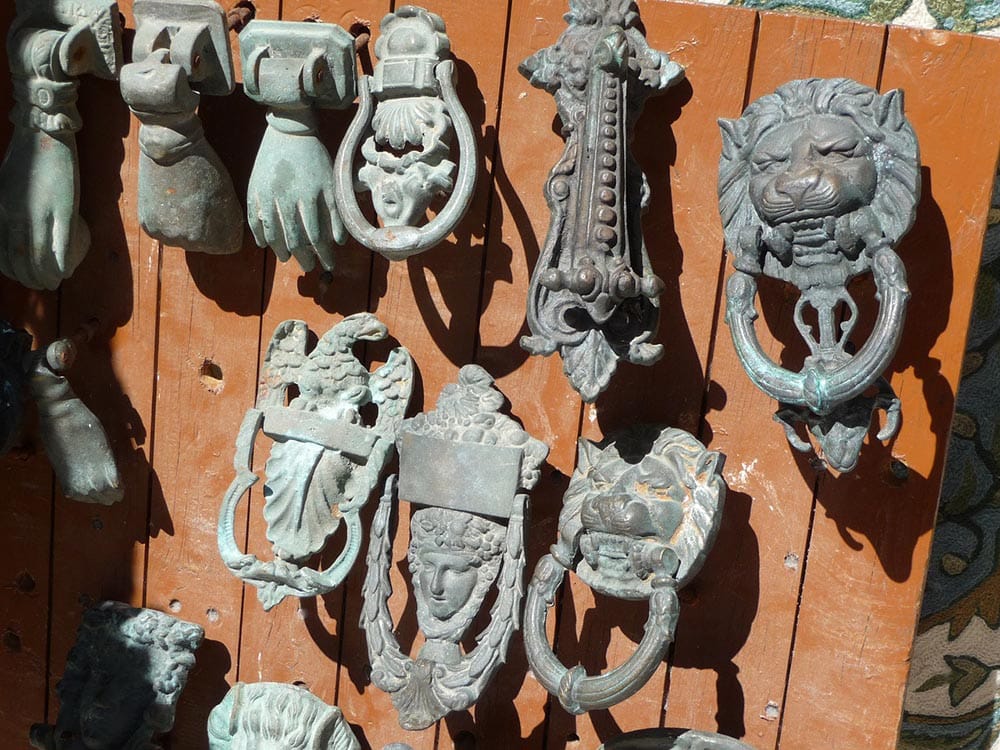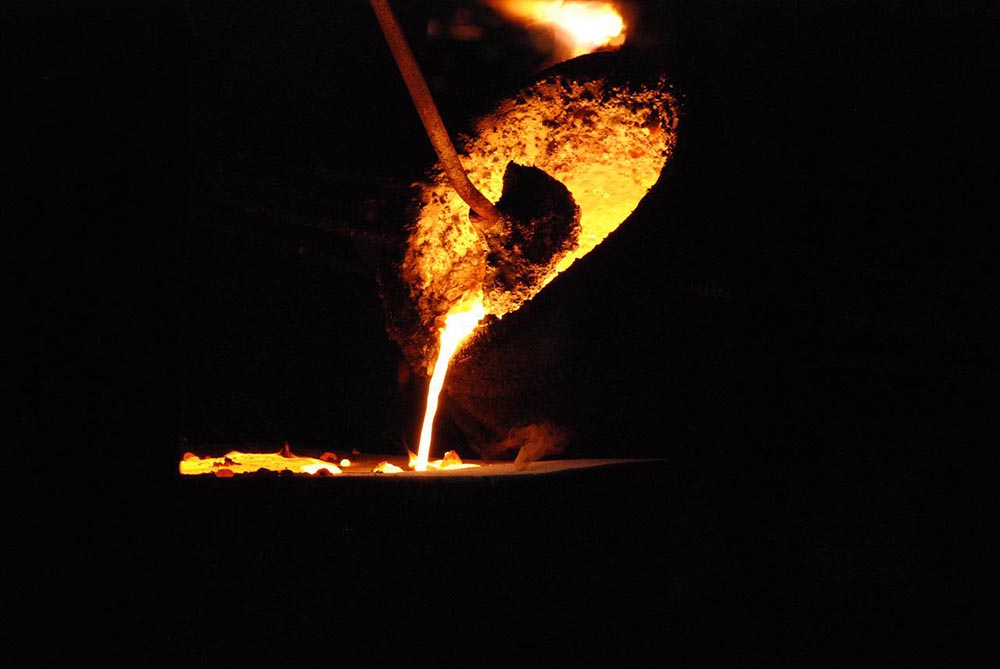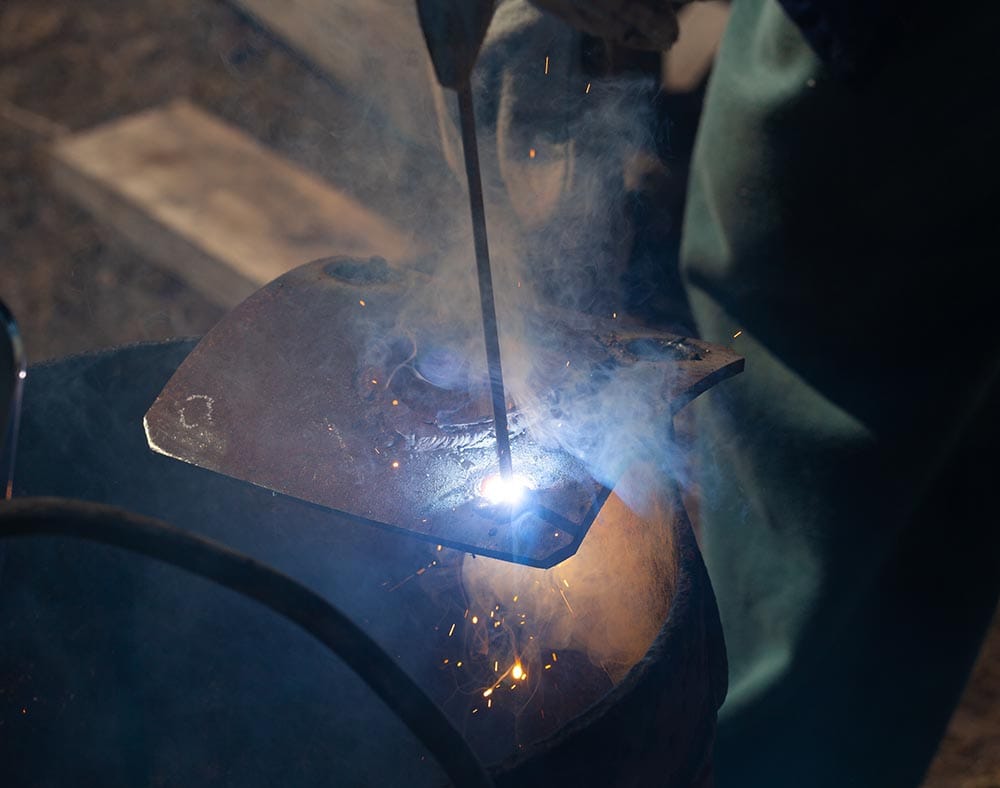Can You MIG Weld Cast Iron? The Surprising Answer
Last Updated on

Metal Inert Gas (MIG) welding is one of the most popular welding methods for home projects and professional work. It’s relatively easy to learn, and it can be used on a variety of materials, including cast iron. But you need to do it with great care to avoid cracking due to its high carbon levels, rapid contraction, and expansion caused by heating.1
Cast iron has a high carbon content, making it difficult to weld. When welding, the carbon moves into the heat-affected area or welds metal. This makes it harder and brittle, which can cause post-weld cracking. However, using the right strategies can get strong welds using MIG.
This article looks at what cast iron is, the cast iron welding processes, and a comprehensive guideline on how to MIG weld cast iron to get strong welds.
What is Cast Iron?
Cast iron is an alloy containing 2%–4% carbon, 1%–3% silicon, manganese, and traces of phosphorus and sulfur. The alloy is created by smelting iron ore in a blast furnace. Cast iron is malleable, elastic, tough, hard, and has high fatigue and tensile strength.
Different types of cast iron include white cast iron, ductile cast iron, gray cast iron, malleable cast iron, mottled cast iron, alloy cast iron, and chilled cast iron. The difference occurs depending on the number of ingredients contained in each.
Cast iron is used in different machines, automotive parts, pipes, pot pans, utensils, metal gates, lamp posts, and bearing surfaces.

Cast Iron Welding Processes
Before we look at how to MIG weld cast iron, let’s look at other possible welding processes that can apply.
- Stick/Arc Welding: Arc welding is the best welding process to weld cast iron if you use the correct welding rods. The rods used feature a special graphite-rich flux that ties up the carbon in the cast iron. This ensures carbon does not move into the weld metal and heat the affected part.
- Gas Welding: This is a great process to weld cast iron because the flame has a lower temperature than an arc. So, carbon migration is not an issue. The problem is that the process is slower, and a lot of heat is needed if the components are large.
- TIG Welding: The process is also used to weld cast iron but is not considered suitable since the open arc process cannot stop carbon migration into the weld metal.
MIG Welding Cast Iron: Before You Start
Choose the Correct Settings
You should MIG weld cast iron using the short circuit mode that offers high-quality results since it produces low welding heat. The low welding heat ensures that excess carbon and other impurities don’t enter the puddle.
Besides, the low heat makes a small arc with low penetration, reducing the risk of cracking. The spray transfer mode supported by high amperage welding machines is unsuitable for cast iron welding since it is too aggressive and hot, which increases the risk of cracking.
Set Wire Speed and Voltage
You need to set a lower wire speed and voltage for cast iron welding than with most other metals like steel. This is because cast iron requires a small arc that slightly melts the surface and provides stronger fusion.
You should not set the typical wire voltage and feed when preheating; this is to avoid overheating the casting. Make sure you can easily control the puddle and fill the edges.
You don’t have to set the heat too low. If you keep the settings too low, the short circuit mode melts the wire instead of the casting leading to weak welds. Check the packing or ask the manufacturer for the correct wire feed voltage and speed since you don’t use the same settings as typical wire.
Select the Best MIG Weld Cast Iron Wire
Nickel-based ERNiFe-CI or ERNi55 is the best wire to MIG weld cast iron. The wire features high-level ductility and tensile strength. This makes it suitable to weld dirty castings, ductile irons, steel, and cast iron.
You can also use ERNi-CI or ERNi99, which is machinable, though it’s costly and weaker. Nickel-based wires are suitable for MIG cast iron welding because they don’t shrink and offer a ductile weld metal. Besides, the wires don’t absorb carbon, thus reducing the risks of cracking.
ERNiFe-CI contains 55% nickel and iron with other few elements. ERNi-CI is almost 100% nickel but lacks the right tensile strength to weld cast iron more effectively.

The 8 Step Process of MIG Welding Cast Iron
1. Determine the Cast Iron Alloy
Use a spark test to identify the cast iron alloy you will be MIG welding. This testing method helps determine if you are working with gray cast iron, malleable cast iron, or nodular cast iron. Gray iron has reddish and short sparks, while ductile irons have yellowish and longer sparks like steel.
Gray iron features dark gray color, while malleable cast iron features a white surface, which gets gray moving towards the center. Nodular iron looks the same as gray iron.
2. Clean the Welding Surface
MIG welding requires clean joints to provide strong cast iron welds. Dirt restricts weld metal flow leading to defects such as undercut and porosity.
Since cast iron is porous, it’s easy for oil to penetrate. You can remove the oil using a mild brake cleaner that doesn’t contain chlorine or preheating the casting to 750°F (400°C). If the casting doesn’t have oil, you should grind or sandblast to clean.
3. Prepare the Casting
Remove cracks and prepare the cast iron joint using a hammer and chisel. Then, use a die grinder featuring carbide burrs or a small diameter grinder to make the casting ready for welding. Since cast iron is brittle and rigid, the broken parts fit with each other.
Depending on the shape and size of your broken piece, you can fit and tack weld the part. Then, make a groove like when you are fixing a crack.
4. Preheat the Castings
You need to preheat the castings to prevent temperature variations. The process controls the fast expansion of your casting when welding and allows for faster cooling after welding. Preheating also reduces the risks of cracking and prevents carbon from moving in the weld metal. Use a flame torch or an oven to preheat at temperatures 500°F (260°C).
When using the flame torch, move it over your casting and pay more attention to the thicker sections. Then, use a temperature stick on the surface to determine the temperature. When the temperature stick melts evenly, then you can start the welding.
If you preheat the castings, you have to weld them in good time to ensure it doesn’t get cold. While welding, avoid cold drafts to protect the preheating temperature. For a big casting, you can insulate using a welding blanket to avoid cold drafts.

5. Weld Short Bead to Avoid Uneven Temperatures
Since cast iron is brittle, you should weld short beads to prevent putting excess heat inside. You need to weld 1″ (2.5 cm) beads. How you place the beads determines the amount of heat inside the metal. Avoid placing each bead next to each other to minimize cracking risk.
Ensure they are spread along the joint to disperse the heat. Don’t overheat the casting when welding. You can know you are overheating when the casting turns overly red.
6. Peen the Beads to Avoid Shrinkage Stress
Peening involves tapping all over the red-hot bead using a hammer after you weld each. Begin from the crater and apply rapid blows to indent the weld metal lightly. Peening helps stretch your welding metal and overcome shrinkage forces.
This is also a great way to reduce the cracking risk. Don’t hit the bead too hard as this could harden the weld metal and complicate the work.
7. Post Heat the Casting
Post heating ensures that the casting has at least a similar preheating temperature spread evenly. Identify the temperature and reheat your casting if necessary.
8. Protect Your Casting to Cool Down
The last step involves protecting your casting by allowing it to cool slowly. This helps prevent cracking and preserves the metal characteristics. The slower the casting cools, the better results you get.
Insulate the whole casting to allow it to cool evenly until it reaches the average temperature you can touch with your hand. Cover it with welding blankets, dry sand, or fiberglass material. If you used an oven to preheat, you could also use it to cool the casting down.
Tips/Precautions to Take When Welding Cast Iron
Welding cast iron is difficult because of its high carbon content. This makes it susceptible to breaking and cracking because it is brittle. Therefore, you must follow some precautions and tips to ensure that your project doesn’t fall apart. Here are a few tips and precautions to follow:
- Preheat the casting to have an even temperature and prevent cracking
- Don’t start the arc on the castings, but in previous beads or joint
- Make sure you fill the crater by filling all gaps because shrinkage forces make it crack
- If you have irregular casting, start welding the thicker parts
- If a crack develops as you weld, stop and drill holes at both ends to ensure it does expand
- Put the grounding or working cramp on the casting for effective connection
- Avoid drafts because they displace the shielding gas

MIG Cast Iron Welding Without Preheating
You can MIG weld cast iron without preheating for the following situations:
- Castings are too complicated and big to preheat effectively
- Don’t have the right preheating equipment
- You cannot disassemble the part, and it will crack when preheated
- Simple and small casting
To MIG weld cast iron without preheating, you should use nickel wires (ERNi99 and ERNi55). Also, use short beads and apply constant peening. Leave each bead to cool down before you weld the next.
If you don’t preheat, your casting next to the weld will be weak and at a high risk of cracking. Here are steps and tips to MIG weld cast iron without preheating:
- Use nickel wires designed for cast iron
- Use the lowest wire voltage and speed to melt the wire correctly and get low penetration
- Mig weld 1/2″ to 1″ straight beads
- Peen the bead when red hot
- After you weld each bead, allow it time to cool down until you can touch it with your hand. It should be about 100°F (38°C). This is the most crucial step in MIG welding cast iron without preheating.
- Weld another short bead at a different joint area and repeat the process until you complete the job.
Note that avoiding the preheating step does not mean you weld cold cast iron. If you do, you get poor results, so try to warm your casting up to 75°F (24°C) before you weld. Also, never weld without preheating if the cast iron is thick or damaged in the center.
Final Thoughts
It is possible to MIG weld cast iron, although great care is needed to prevent cracking because of its high carbon content. There are different types of cast iron, but you can MIG weld them the same way since they have almost similar properties such as castable, malleable, elastic, and high tensile and fatigue energy.
As you weld, apply short circuit mode because it offers high-quality welds. You should use nickel-based ERNiFe-CI wire because of its high tensile strength and ductility.
When welding, weld short beads to ensure even temperatures and peen them to prevent shrinkage stress. After welding, allow the casting to cool down slowly to ensure you get great results. And there you have it—a successfully MIG-welded cast iron.
